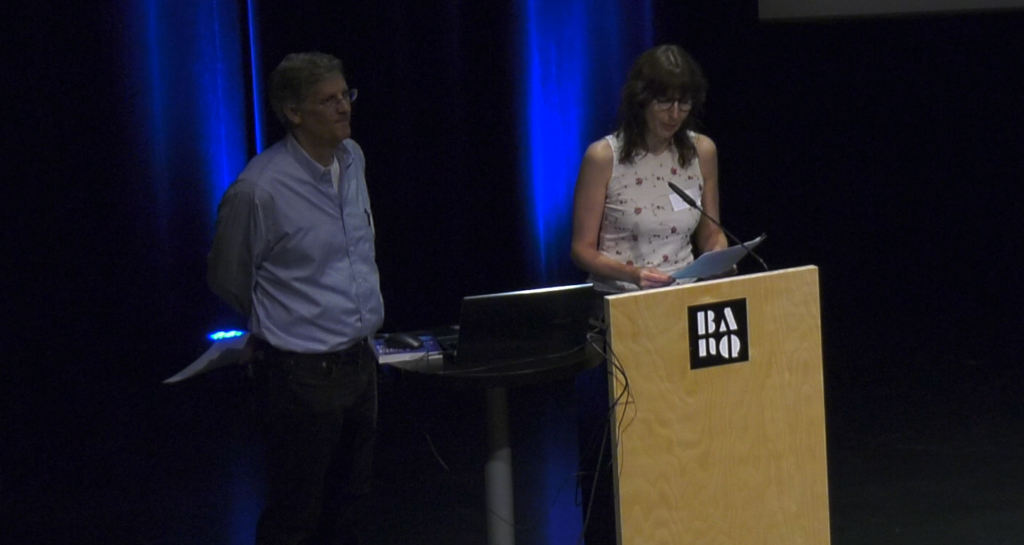This event took a humanist look at the changes new technologies are imposing on the performing arts.

Hugo Samson
From June 1st to 3rd this past summer the Grande Bibliothèque of the BAnQ hosted the international and interdisciplinary conference “Reinventing the Stage: Innovation, Creation, Dissemination”. Co-organised by the cinEXmedia partnership, the event sought to reflect on the redefinition of the space of the stage in light of recent technological advances.
“Where are we at today in the performing arts?” asked Ana Sokolović to open the conference. Sokolović is a composer, a professor in the Faculté de musique at the Université de Montréal and a co-organiser of the event.
She posed this question to another of the event’s co-organisers, Olivier Asselin, a professor in the Département d’histoire de l’art et d’études cinématographiques at the Université de Montréal. ‘Today the stage, seen as a unity of space and time and as a space where audience and performance meet, is an open question concerning all the arts,” he replied.
In the presentations which followed, the participants in the “Reinventing the stage” conference addressed this question, each in their own manner.
An Event in Keeping with the Zeitgeist
The physical presence of an audience in a shared space has often been given as a definition of the performing arts. Theatre, classical music, opera, the circus: these artistic practices are generally characterised by the stage on which they take place. In today’s context, however, in which we see numerous technological changes, this definition is in the process of changing.
For Asselin, “there have always been experiments, especially in modern art, which called into question the idea that the performing arts had to be defined by a shared presence in the same space around a stage … but the pandemic took all that away.”
In particular, new forms of interactive performance emerged from the new ecology of the performing arts to which the pandemic gave rise. For this reason, many conference presentations focused on domestic space and its reconfiguration in the wake of the recent lockdowns. “We saw many experiments which took theatre into people’s domestic space, by Zoom or physically, and which gave people theatrical roles,” Asselin remarks. They were brought into the story: spectators played active roles in modifying the narrative.”
For Asselin, the conference was an opportunity to take note of the fact that those creating and disseminating the performing arts have been able to recognise the potential of new technologies and that, through them, they have discovered a wealth of means of expression.
In keeping with one of the research areas of cinEXmedia, one of whose goals is to examine the therapeutic effects of the audiovisual experience, the conference addressed topics such as inclusivity, accessibility and diversity. “The arts are also a way to distribute power and to share tangible space,” Asselin argues. During the event, participants thus explored the idea that new technologies can open up artistic practices to a greater extent and more faithfully represent the audiences which thrive on them.
Lectures of Every Description
A multidisciplinary assortment composed of some thirty French- and English-speaking researchers, producers, disseminators and creators took part in the conference, which presented not only lectures and panel discussions but also demonstrations and innovative lecture-performances by artists such as Gabo Champagne (Naissances) and Marie-Annick Béliveau (Mezzosoprano 2.0).
“A dialogue [between disciplines] was quickly established thanks to the material object we have in common: the stage,” professor Asselin explained. The technologies used over the past twenty or thirty years by artisans in every [performing arts] discipline are also the same,” facilitating their integration during discussions at the conference. The conference covered, therefore, theatre, dance, music, performance art and cinema, among other practices.
A Touch of Hope
Asked what conclusions could be drawn from the conference, Olivier Asselin replied with a touch of hope: “We can take a humanist look at the problem of the relations between technology and the stage. Some people say that as soon as you put technology on the stage something is lost.… The paradox [of this observation] is that in the end we forget the physical presence of our friends, of the people we love. And technology is there to create new kinds of presence, but also to make us feel non-mediated presence even more.”
